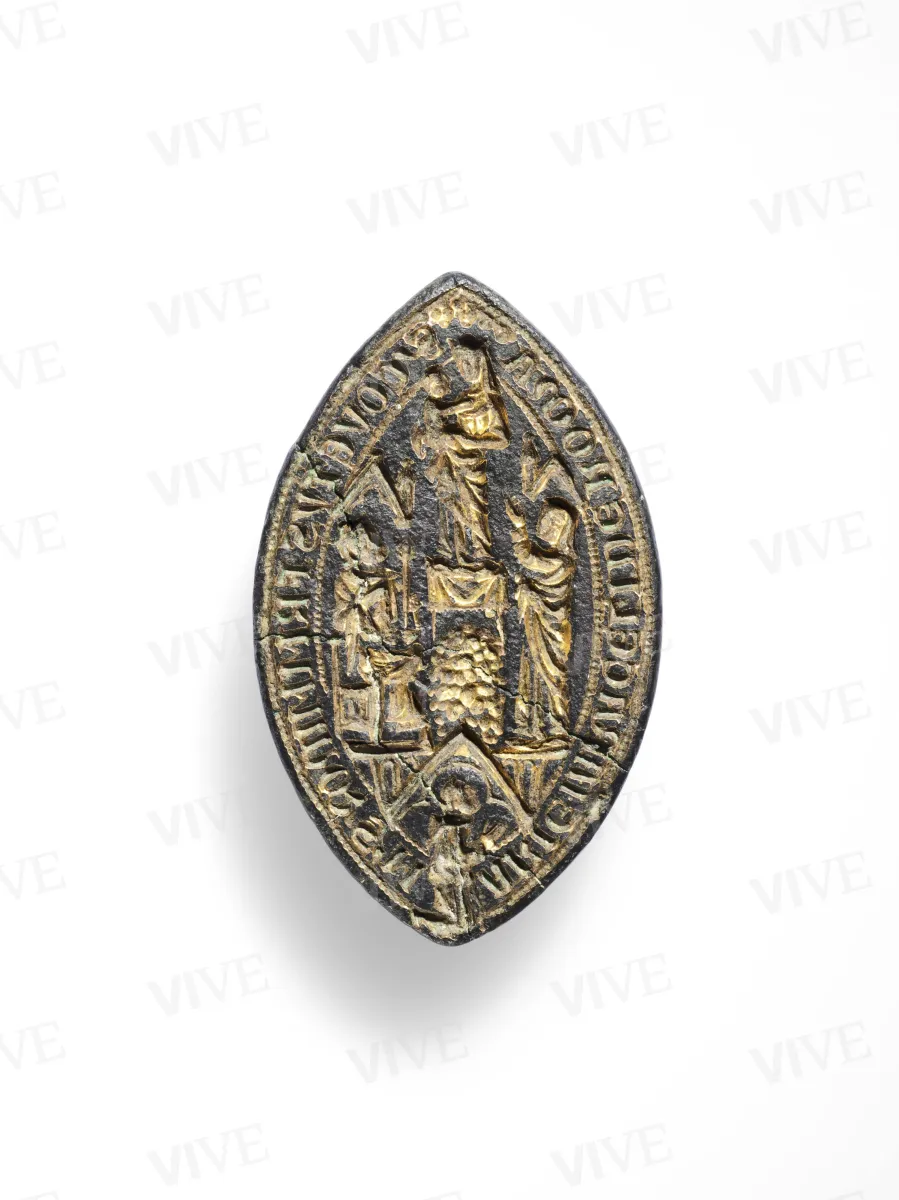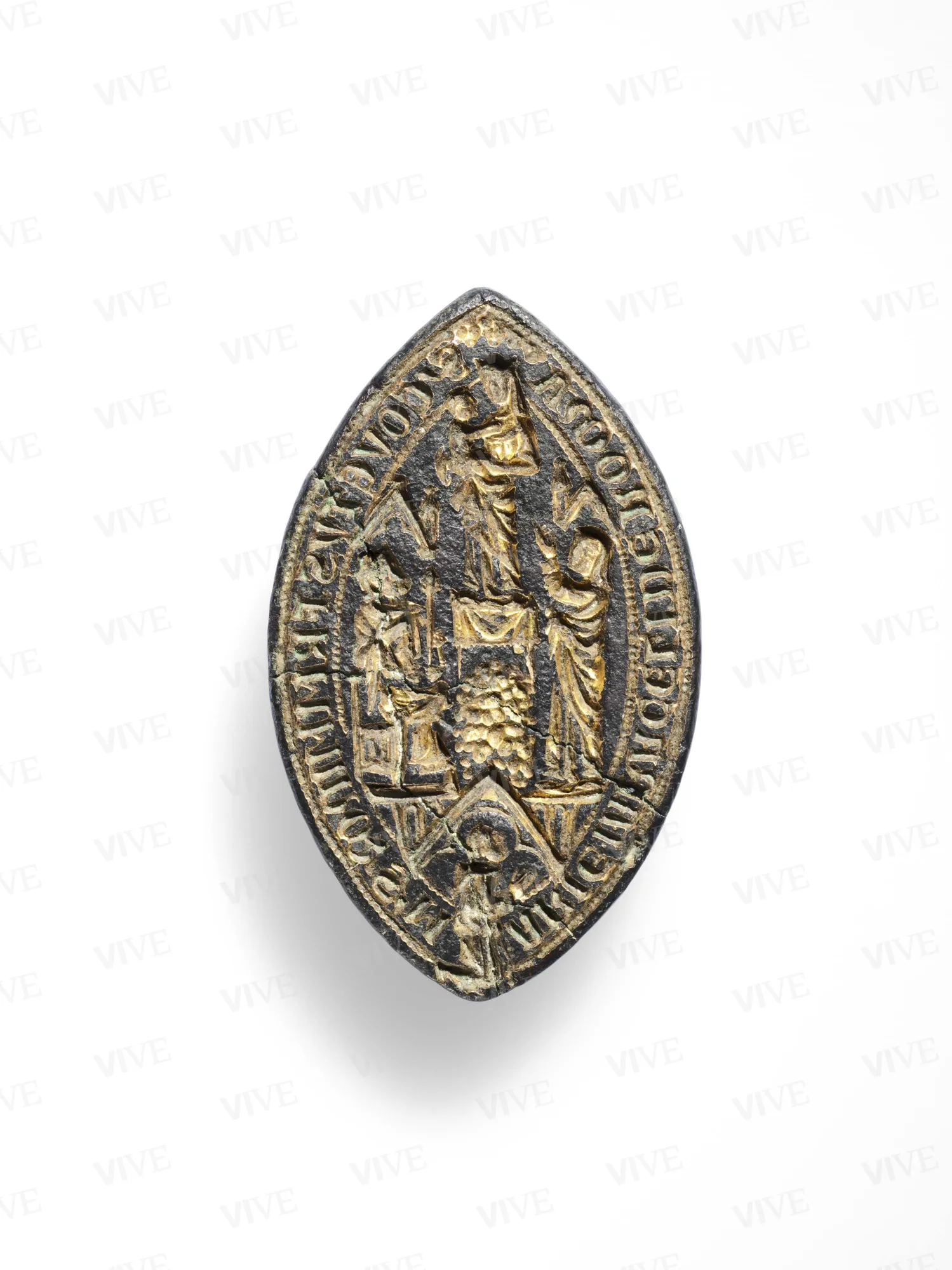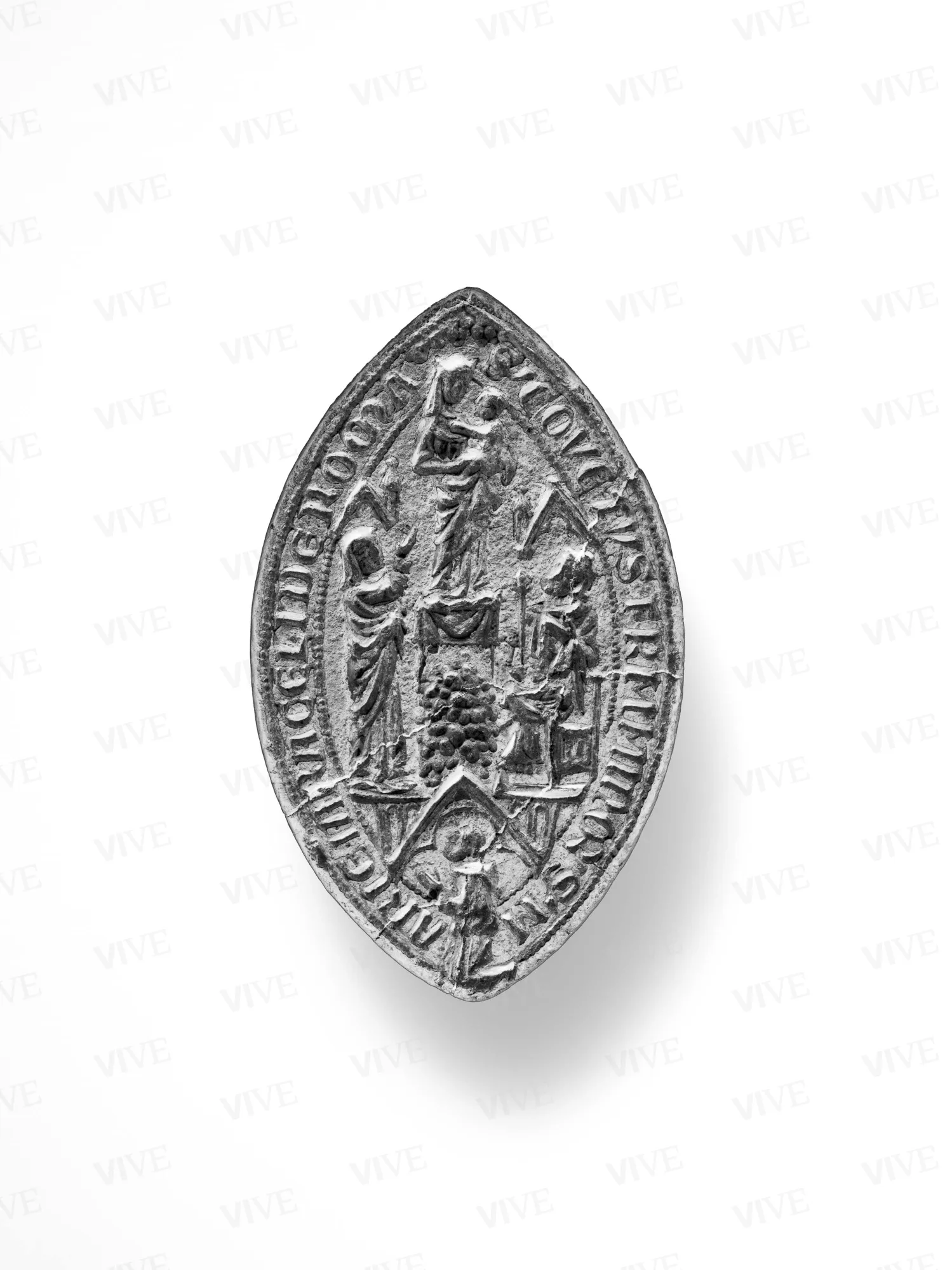Matrix for the seal of the convent of Santa Maria in Aracoeli, Rome
Milieu Pietro Cavallini ? 1290-1310 ca
Bronze seal matrix depicting, on the left (on the right in the wax seal), the Tiburtine Sibyl pointing to Caesar Augustus (also known as Octavian), on the right (left in the wax seal), the apparition on the Capitoline Hill of the Madonna and Child. The two figures are framed by a trefoil gable. The inscription running along the margin identifies the item as a seal of the convent of Santa Maria in Aracoeli. Below, within a cusp that is also trefoiled, is the figure of a kneeling Franciscan friar, who is very likely the convent's guardian father.
Bronze seal matrix depicting, on the left (on the right in the wax seal), the Tiburtine Sibyl pointing to Caesar Augustus (also known as Octavian), on the right (left in the wax seal), the apparition on the Capitoline Hill of the Madonna and Child. The two figures are framed by a trefoil gable. The inscription running along the margin identifies the item as a seal of the convent of Santa Maria in Aracoeli. Below, within a cusp that is also trefoiled, is the figure of a kneeling Franciscan friar, who is very likely the convent's guardian father.
Details of work
Catalog entry
The seal reproduces with remarkable precision the iconography of the apse fresco in the church of the Franciscan convent of Aracoeli (Tomei 1982; Tomei 2000, 106–107) executed by Pietro Cavallini between the end of the thirteenth century and the beginning of the fourteenth century and destroyed in 1564 during the reconstruction of the church ordered by Pope Pius IV. This can be deduced from the detailed description of the Roman painter's work provided by Giorgio Vasari in his “Life of Pietro Cavallini”: “But the best work that he made in that city was in the said Church of Araceli on the Campidoglio, where he painted in fresco, on the vaulting of the principal apse, the Madonna with the Child in her arms, surrounded by a circle of sunlight, and beneath is the Emperor Octavian, to whom the Tiburtine Sibyl is showing Jesus Christ, and he is adoring Him; and the figures in this work, as it has been said in other places, have been much better preserved than the others, because those that are on the vaulting are less injured by dust than those that are made on the walls” (Vasari, 1969, pp. 186-187). This description coincides exactly with what is reproduced, in summary form for obvious reasons of space, in the matrix. It is therefore a testimony of extraordinary importance, a truly unique artifact, for what must have been one of the most important frescoes executed by Cavallini in Rome, probably between the late thirteenth and early fourteenth centuries, when the master executed the fresco for the funeral monument of Cardinal Matteo d'Acquasparta (d. 1302) in the same church. According to another hypothesis, however, it was executed in the early 1290s (Romano 2017, 62). The particular volumetric rendering of the figures might suggest the direct involvement of Cavallini in the execution of the seal. The legend of the apparition of the Virgin to Augustus Caesar originates in the high Middle Ages and is first reported by John Malalas (sixth century); later, in the Mirabilia Urbis Romae, the miraculous apparition is associated with the Capitoline hill and the figure of the Tiburtine Sibyl (Valentini, Zucchetti 1946, 28–29), with the Virgin announcing to the emperor, chosen for his human virtues, the coming of the Son of God. The miraculous episode is depicted in several works from the middle ages, including an important miniature from the Liber de temporibus et aetatibus (Biblioteca Estense, ms Lat. 461, f. 92v) and a panel in Stuttgart (Staatsgalerie, inv. 90) from the late fourteenth century.
Stefania Paone
Entry published on 12 February 2025
State of conservation
Good.
Inscriptions
Along the edges “+ S. CONVENTUS FRATRUM MINORUM S. MARIE ARACELI DE ROMA.”
Provenance
Rome, Collezione Pasqui.
Exhibition history
Rome, Palazzo Venezia, Bonifacio VIII e il suo tempo, April 12–July 16 2000;
Rome, Musei Capitolini, Dipinti romani tra Giotto e Cavallini, April 8–June 29 2004.
References
Valentini Roberto, Zucchetti Giuseppe, Codice topografico della città di Roma, vol. III, Roma 1946, pp. 28-29;
Vasari Giorgio, Le Vite de' più eccellenti pittori scultori e architettori,a cura di Bettarini Rosanna, Barocchi Paola, Firenze s.d. (1969), pp. 186-187;
Bascapè Giacomo C., Note sui sigilli dei Francescani, in «Collectanea Franciscana», 32 (1962), 148-164;
Bascapè Giacomo C., Sigillografia, Milano 1978, pp. 211-212;
Tomei Alessandro, Un contributo per il perduto affresco dell’Aracoeli, in «Storia dell’Arte», 44 (1982), pp. 83-86;
Tomei Alessandro, Pietro Cavallini, Cinisello Balsamo 2000, pp. 106-107;
Tomei, in Righetti Tosti-Croce Marina (a cura di), Bonifacio VIII e il suo tempo, Anno 1300 il primo giubileo, catalogo della mostra (Roma, Palazzo Venezia, 12 aprile-16 luglio 2000), Milano 2000, p. 203, n. 158;
Strinati Tommaso, Maestro romano attivo tra la fine del XIII e l'inizio del XIV secolo, Matrice di sigillo del convento di Santa Maria in Aracoeli a Roma, in Strinati Tommaso, Tartuferi Angelo (a cura di), Dipinti romani tra Giotto e Cavallini, catalogo della mostra (Roma, Musei Capitolini, 8 aprile-29 giugno 2004) Milano 2004, pp. 68-69, n. 7;
Gardner Julian, The Roman Crucible: The Artistic Patronage of the Papacy: 1198-1304 (Römische Forschungen der Bibliotheca Hertziana 33), München 2013, p. 254;
Leone de Castris Pierluigi, Pietro Cavallini. Napoli prima di Giotto, Napoli 2013, p. 41;
Schmitz Michael, Pietro Cavallini in Santa Cecilia in Trastevere: ein Beitrag zur römischen Malerei des Due und Trecento (Römische Studien der Bibliotheca Hertziana 33), München 2013, pp. 242-245;
Romano Serena, Pietro Cavallini (?); Il perduto affresco absidale con l'Apparizione della Vergine ad Augusto, in La pittura medievale a Roma. Corpus, VI. Apogeo e fine del Medioevo. 1288-1431, a cura di Romano Serena, Milano 2017, pp. 62-63.














